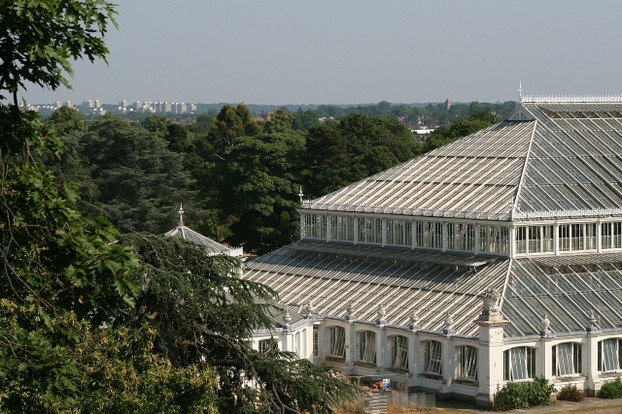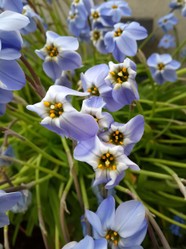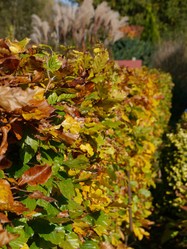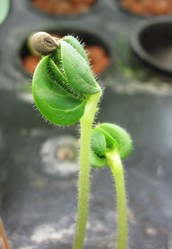There are about ten thousand plants in the glasshouse, so I can only mention but a few.
Musella lasiocarpa, the lotus flowered banana, so named because its flower resemble a lotus flower, is an Asian plant which is used as a source of healing herbs and its leaves are used for weaving fabrics. In an age when manmade fibres are becoming less viable, as they are oil-based, we will need natural alternatives. The plant is good for erosion control on steep hillsides, as it has strong and widespread roots.
Another plant with medicinal use is Dioscorea deltoidea, the Nepal yam. This is an indeible yam,but its roots, vigorous rhizomes, are a source of steroids with medicinal uses, some of which are anti-inflammatories. Kew is preserving this plant so that its seeds can be collected and used in medicinal research.
Some are extinct in the wild. Take the case of Abutila pitcairnense, the yellow fatu. Native to Pitcairn Island in the Pacific, the refuge of the Bounty Mutineers, it is extinct in its native home due to predation by goats and rats, and its only home is now Kew. Another endangered one is Banksia brownii, which is an Australian plant with reddish brown flowers whose seeds break their dormancy in bushfires, which serve to spread them. In its native land it is endangered by development, so its being protected at Kew.
Or let's turn to the tree on whose leaves Robinson Crusoe might have looked. Alexander Selkirk, a privateer [legal pirate permitted to raid the king's enemies] had no confidence in his equally villainous, but incompetent captain and so asked to be marooned on Juan Fernandez Island off South America, where he remained three and a half years. He was wise, for the ship sank and the crew were captured by the Spanish, who were not pleased with English pirates..There Selkirk, one of the men on whom Defoe based his tale of Robinson Crusoe, fed on goats introduced to the island as food supplies by British privateers and whatever else he could eat. The cabbage tree, Dendroseris lioralis, has large cabbage shaped leaves which are excellent goat food, though they are too rubbery for humans to digest. Found only on Juan Fernandez this small, easily cultivatable tree is easily stripped of its leaves by goats, so it is being propagated at Kew. By the way, the name cabbage tree is a popular colloquial, non-scientific name applied to a few different species of tree.
Ten thousand species is more than I can detail here, but I hope that you can get a taste of the Temperate House, a sip from the wine cellar of horticultural glory.It opens tomorrow, fifth of May 2018, in time for the Spring bank holiday weekend. Expect it to be busy!








 Pilgrimage. A review20 days ago
Pilgrimage. A review20 days ago
 Leo the Fourteenthon 05/09/2025
Leo the Fourteenthon 05/09/2025
 The Melsonby Hoardon 03/25/2025
The Melsonby Hoardon 03/25/2025



Comments
Of course. The Kew system is humane and relaxedl
Thank you!
The Royal Botanic Gardens, Kew site advises us that "We have a wide variety of cafés and restaurants at Kew Gardens. Look for seasonal specialties and food foraged from our Gardens. All our cafés and restaurants source seasonal and local produce. We use as many ingredients from the Gardens as possible and offer a wide range of plant-based options."
Tea time carries a 2:00 p.m. to 4:45 p.m. daily schedule there.
Do Kew police officers get meal and tea breaks? Might they order tea at the gift shop or at the Kew-operated eateries?
Three shiftsvofb8 hours makes sense, so it is probably that
Thank you!
Twenty-four-hour coverage here generally equates to three eight-hour shifts daily. The generally 40-hour week therefore figures five days weekly.
Is that what the Kew police force works?
No. Few British police officers routinely carry arms. Anti-terrorist officers and diplomatic and royal protection squad members carry them,as do police officers in Northern Ireland. There is twenty four hour coverage.
The last sentence in the first paragraph to the first subheading, The Temperate House, describes Kew Gardens as perhaps "the only botanical garden with its own police force, constables who deal with minor infringements and who perform a patrol and ranger service, but who are rarely called to use their powers."
Does that police force carry arms?
Is there 24/7 police coverage?
Probably. The American air force fed well and were generous. My father was very grateful.
Thank you for your comment Nov. 26, 2019, in answer to my previous question Nov. 25, 2019.
It intrigues me that your father mentioned "can loads of good stew."
Might that stew have been beef?
Unitedstatesians particularly pride themselves on their beef stew.
I don't know whether there were set aside plants or what happened to the sprayed ones.
My father was due to be flown out when he was asked to check that nothing had been accidentally left, but the plane took off without him.
When I said that he ate American style I meant that instead of the short rations that the British suffered he enjoyed the bounteous supplies of the US military. He told me that he was given can loads of good stew, and that after four days with barely any food he just ate!
frankbeswick, Did the Channel Isles head gardener manage to set aside back-up plants? Do we know what happened to the sulfuric acid-sprayed plants? (The actor Richard Harris said in the film that he described as the one he wished he'd never acted in, Caprice, that everyone underestimates the English.)
That's an endearing, inspiring story about your father that deserves to be told. How was he "accidentally abandoned"? Were the identifies of the food served "American style" (perhaps your side of the pond's fish and chips were this side's fish and fries) in the field kitchen included in your father's memoirs?